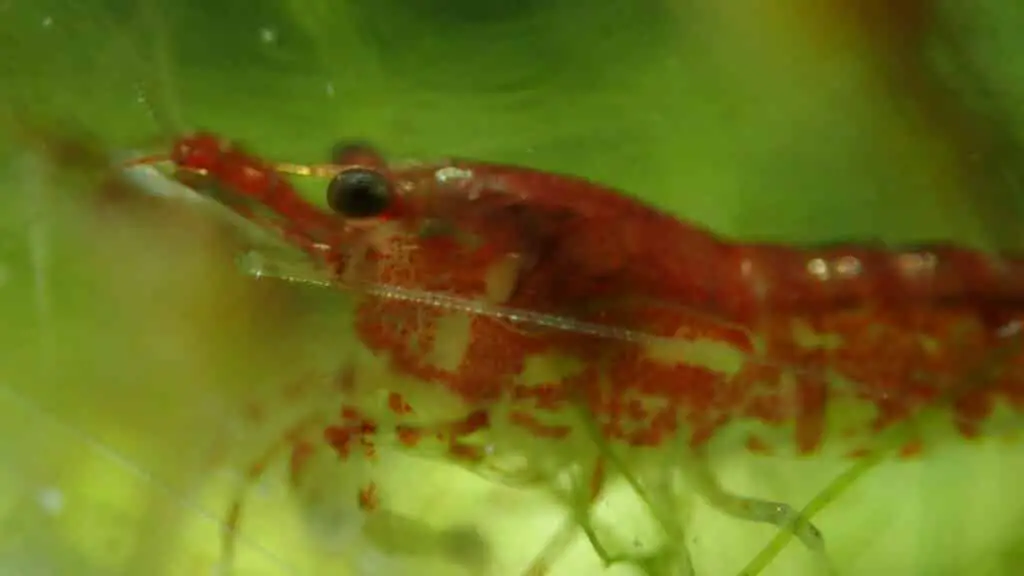The Comprehensive Guide to Improving Cherry Shrimp Color Naturally
Cherry shrimp are prized for their vivid colors, but sometimes these hues may be less vibrant than desired. Enhancing your cherry shrimp’s color is achievable through a variety of methods.
This guide will offer extensive food options and other strategies to help brighten your shrimp’s color and support their overall well-being in your aquarium.

list of natural foods that can improve shrimp color
- Marigold petals: These flowers are rich in carotenoids, which contribute to improved shrimp color. Make sure the petals are pesticide-free before using them.
- Paprika: A natural source of carotenoids, a small amount of paprika can enhance your shrimp’s coloration.
- Spinach and kale: Leafy greens like spinach and kale provide nutrients that promote shrimp health and color. Blanch the leaves before feeding them to your shrimp.
- Spirulina: This blue-green algae is packed with vitamins, minerals, and carotenoids, making it a great option for boosting shrimp color.
- Dandelion leaves: These common plants contain valuable nutrients and pigments that can enhance your shrimp’s color. Ensure they are pesticide-free before using them as food.
- Mulberry leaves: Rich in nutrients, mulberry leaves can be a good addition to your shrimp’s diet to promote coloration. Blanch the leaves before feeding them to your shrimp.
- Carrots: Blanching and feeding small pieces of carrots can provide carotenoids to improve your shrimp’s color.
- Pumpkin: This nutrient-dense vegetable is another source of carotenoids that can help enhance your shrimp’s color. Serve it blanched and in small portions.
- Sweet potatoes: Rich in beta-carotene, sweet potatoes can contribute to improved shrimp coloration. Blanch and cut them into small pieces before feeding them to your shrimp.
- Peppers: Bell peppers, especially red ones, contain carotenoids that can benefit shrimp color. Remove the seeds and blanch the pepper before feeding it to your shrimp.
- Almond leaves
 : Indian almond leaves release beneficial tannins and nutrients that can enhance shrimp color and health.
: Indian almond leaves release beneficial tannins and nutrients that can enhance shrimp color and health. - Tomatoes: These fruits contain lycopene, a carotenoid that can help improve shrimp color. Remove the seeds and blanch the tomato before feeding it to your shrimp.
- Moringa leaves: Rich in nutrients and pigments, moringa leaves can be a valuable addition to your shrimp’s diet. Dry and crush the leaves before feeding them to your shrimp.
- Chlorella: This green algae is rich in nutrients, vitamins, and pigments that can contribute to improved shrimp color.
- Bee pollen: Containing various nutrients and pigments, bee pollen can help enhance your shrimp’s coloration. Crush the pollen before adding it to your shrimp’s food.
- Krill: This crustacean is a source of astaxanthin, which can improve shrimp color. Freeze-dried or powdered krill can be added to your shrimp’s diet.

- Watermelon: This fruit is rich in vitamins and lycopene, which can contribute to enhanced shrimp coloration. Remove the seeds and blanch the watermelon before feeding it to your shrimp.
- Red cabbage: Packed with antioxidants and nutrients, red cabbage can improve shrimp color. Blanch the leaves before feeding them to your shrimp.
- Goji berries: These berries contain carotenoids that can help enhance your shrimp’s color. Crush the dried berries and mix them with your shrimp’s food.
- Mangold: Also known as Swiss chard, mangold is a leafy vegetable that provides essential nutrients for shrimp color enhancement. Blanch the leaves before feeding them to your shrimp.
- Apricots: These fruits are rich in carotenoids and can contribute to improved shrimp color. Blanch and cut them into small pieces before feeding them to your shrimp.
- Nori: This seaweed is packed with vitamins, minerals, and pigments that can boost your shrimp’s color. Cut it into small pieces and add it to your shrimp’s food.
- Peas: These legumes are rich in nutrients that can help enhance your shrimp’s color. Blanch and remove the shells before feeding them to your shrimp.
- Nasturtium flowers: These flowers are rich in carotenoids and can improve shrimp coloration. Ensure they are pesticide-free before using them as food.
- Red algae: These algae contain pigments that can contribute to improved shrimp color. Add dried red algae to your shrimp’s food.
- Cantaloupe: This fruit is rich in beta-carotene and can help enhance your shrimp’s color. Remove the seeds and blanch the cantaloupe before feeding it to your shrimp.
- Açai berries: These berries contain antioxidants and pigments that can improve shrimp coloration. Crush the dried berries and mix them with your shrimp’s food.
- Blueberries: These fruits are rich in antioxidants and can contribute to enhanced shrimp color. Crush the dried blueberries and mix them with your shrimp’s food.
- Rose petals: Rich in pigments, rose petals can help improve your shrimp’s color. Make sure the petals are pesticide-free before using them.
- Broccoli: This vegetable is packed with nutrients that can enhance your shrimp’s color. Blanch and cut it into small pieces before feeding it to your shrimp.
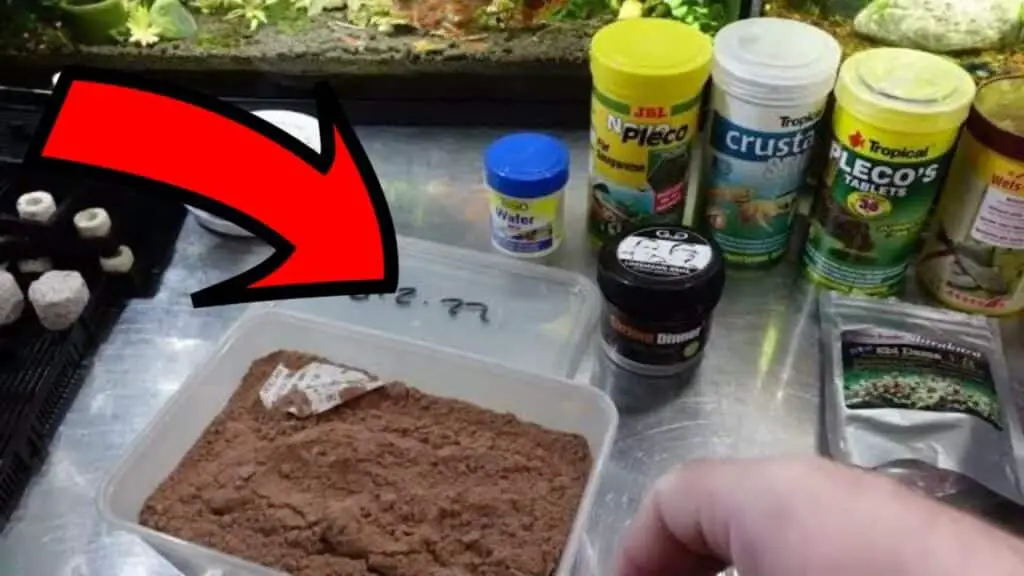
- Red bell peppers: These vegetables are rich in carotenoids and can contribute to improved shrimp coloration. Blanch and dice them before feeding them to your shrimp.
- Papaya: This tropical fruit is packed with nutrients, including carotenoids, which can help enhance your shrimp’s color. Remove the seeds and blanch the papaya before feeding it to your shrimp.
- Raspberries: These fruits are rich in antioxidants and pigments that can help improve shrimp coloration. Crush the dried raspberries and mix them with your shrimp food.
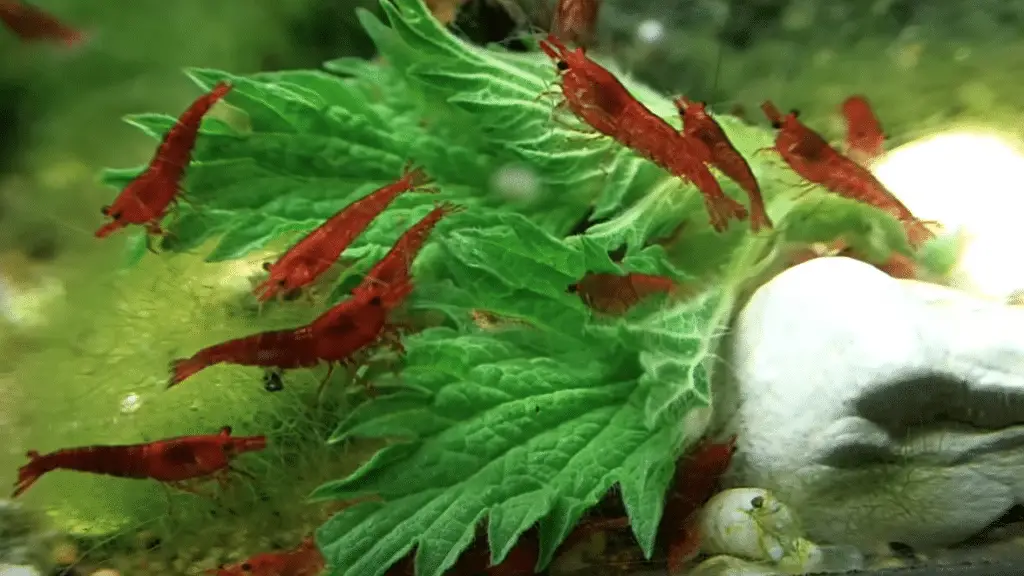
The Impact of Substrate and Background on Cherry Shrimp Coloration
A dark substrate and background can significantly impact the coloration of your cherry shrimp. The color contrast created by these darker elements helps to make the shrimp feel safer, which ultimately leads to a reduction in stress and an improvement in their overall coloration.
Experimenting with various dark substrates and backgrounds can help you find the optimal setup for your cherry shrimp, ensuring they display the most vibrant colors possible.
When cherry shrimp perceive their environment as safe, they are more likely to showcase their natural coloration, which is essential for their well-being and your enjoyment.
In the wild, cherry shrimp rely on their ability to blend into their surroundings to avoid predators. Although selective breeding has introduced a variety of vibrant colors to cherry shrimp, they still instinctively seek camouflage to feel secure.
A dark substrate, such as black gravel or sand, provides a contrast that allows the cherry shrimp to stand out, while also making them feel secure.
The darker background color can mimic the natural environment, helping them to feel at ease and encouraging their pigments to shine.
Studies have shown that shrimp kept on darker substrates tend to exhibit more intense coloration than those kept on lighter ones.
Similarly, a dark background color, like black or deep blue, can enhance the shrimp’s color intensity. The background helps create a sense of depth and security, allowing the shrimp to feel more comfortable in their environment.
Moreover, darker backgrounds can also have a positive impact on the overall aesthetics of your aquarium, as they can help to showcase the colors of not only your shrimp but also your aquatic plants and other tank inhabitants.
When choosing a substrate and background, it’s essential to consider the specific needs of your cherry shrimp. Experiment with different materials and colors to find the ideal combination that enhances your shrimp’s coloration and promotes a healthy, stress-free environment.
By creating an optimal setup, you’ll be able to enjoy the vibrant, intense colors of your cherry shrimp to their fullest potential.
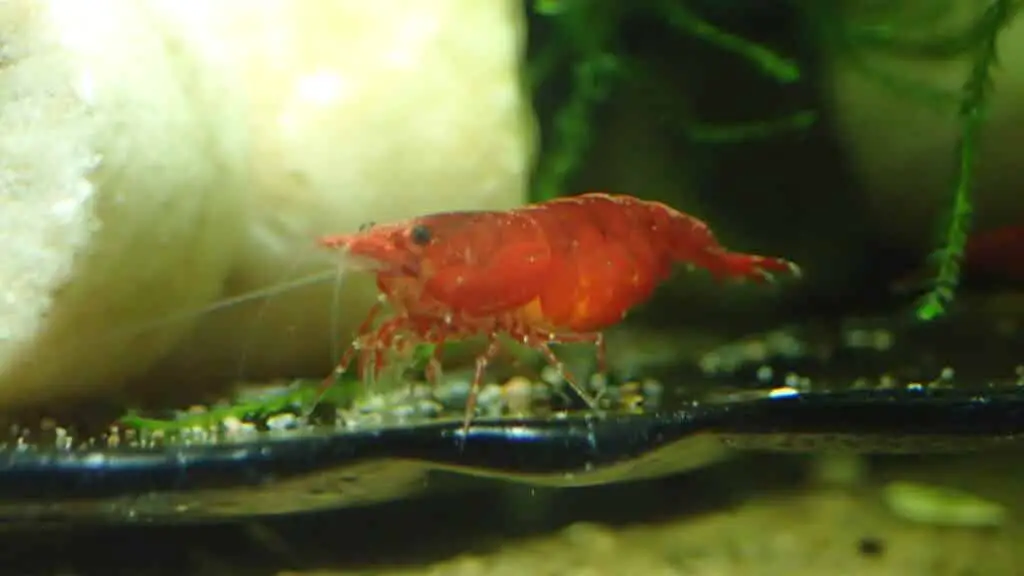
Age and Cherry Shrimp Color Development: The Importance of Maturity in Color Intensity
The coloration of cherry shrimp can change significantly as they mature, with juvenile shrimp often displaying less intense coloration compared to their adult counterparts.
To accurately evaluate your shrimp’s color and potential for vibrant hues, it’s crucial to wait until they are at least one month old. As your shrimp continue to grow and mature, you may notice a gradual enhancement in their coloration, ultimately resulting in more vivid and striking colors.
Young cherry shrimp, or shrimplets, typically have a more subdued coloration due to their early stage of development. This less intense appearance serves as a natural defense mechanism, helping them blend into their environment and avoid potential predators.
As the shrimp grow and develop, their pigments begin to accumulate, and their coloration gradually intensifies. This process can continue for several months until the shrimp reaches its full potential for color vibrancy.
Female cherry shrimp generally exhibit more striking coloration than males as they age. Studies have shown that the color intensity in female shrimp can increase by as much as 70% between the ages of 90 and 180 days.
In contrast, male shrimp display a slight increase in coloration through time, although it remains consistently lower than that of females of the same age. The reason for this difference is that adult males are typically smaller and less colorful than adult females.
To ensure that your cherry shrimp develop the best coloration possible, it’s essential to provide them with optimal living conditions, including proper nutrition, water quality, and a stress-free environment.
Offering a balanced diet rich in carotenoids and natural food sources will help promote healthy growth and vibrant coloration. In addition, maintaining stable water parameters, such as pH, GH, KH, TDS, nitrate, and copper levels, is crucial for the well-being of your shrimp.
The age of your cherry shrimp plays a significant role in their color development. By providing your shrimp with proper care and a suitable environment, you can help them reach their full potential for color intensity as they mature.
Remember to be patient and allow your shrimp to grow, as it can take several months for them to achieve their most vibrant and striking colors.
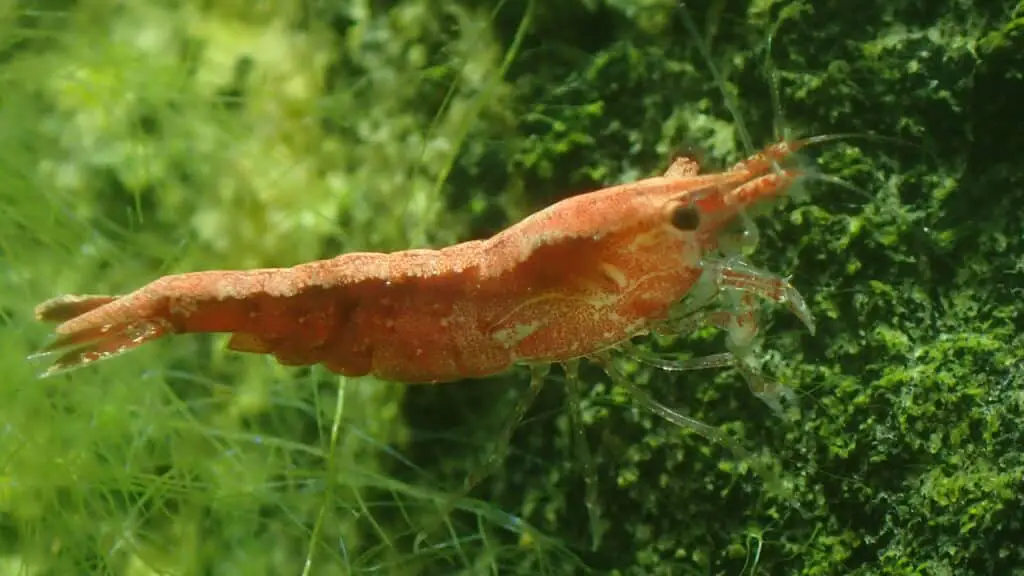
Water Quality and Stress Reduction: The Importance of Pristine Conditions for Cherry Shrimp Health and Color Development
Maintaining excellent water quality is of utmost importance when it comes to ensuring the health, well-being, and color development of your cherry shrimp.
The various factors that contribute to water quality, including pH, GH, KH, TDS, nitrate, and copper levels, play a significant role in keeping your shrimp healthy and stress-free.
By closely monitoring these parameters and performing regular water changes, you can create an optimal environment for your cherry shrimp to thrive and display their best colors.
- pH: The acidity or alkalinity of your aquarium water can directly impact the health and coloration of your cherry shrimp. A pH range of 6.5 to 7.5 is ideal for cherry shrimp, as it closely mimics their natural habitat. Regularly testing the pH level and making adjustments when necessary will help ensure that your shrimp remain in a comfortable environment that promotes vibrant coloration.
- GH (General Hardness): GH measures the amount of dissolved minerals, primarily calcium and magnesium, in your aquarium water. Cherry shrimp prefer a GH range of 4 to 8 dGH. Maintaining the appropriate GH level is crucial for proper molting and shell development, both of which contribute to the shrimp’s overall color and appearance.
- KH (Carbonate Hardness): KH is a measure of the water’s buffering capacity or its ability to maintain a stable pH. Cherry shrimp do best in a KH range of 1 to 4 dKH. Ensuring adequate KH levels helps prevent sudden pH swings, which can cause stress and negatively affect shrimp coloration.
- TDS (Total Dissolved Solids): TDS is an indicator of the total amount of dissolved substances in your aquarium water, including minerals, salts, and other organic compounds. A TDS range of 150 to 250 ppm is ideal for cherry shrimp. High TDS levels can cause stress and inhibit color development in your shrimp.
- Nitrate: Excessive nitrate levels can be harmful to cherry shrimp and may contribute to stress, which can lead to duller colors. Aim to maintain nitrate levels below 20 ppm by performing regular water changes and using a quality aquarium filter.
- Copper: Copper can be toxic to cherry shrimp, even in small concentrations. Ensure that your aquarium water contains little to no copper by using copper-free tap water, avoiding copper-containing decorations, and monitoring copper levels with a test kit.
Water quality plays a vital role in the overall health and color development of your cherry shrimp.
By maintaining the appropriate water parameters, performing regular water changes, and closely monitoring your aquarium’s conditions, you can create a stress-free environment that encourages your shrimp to display their most vibrant and intense colors.
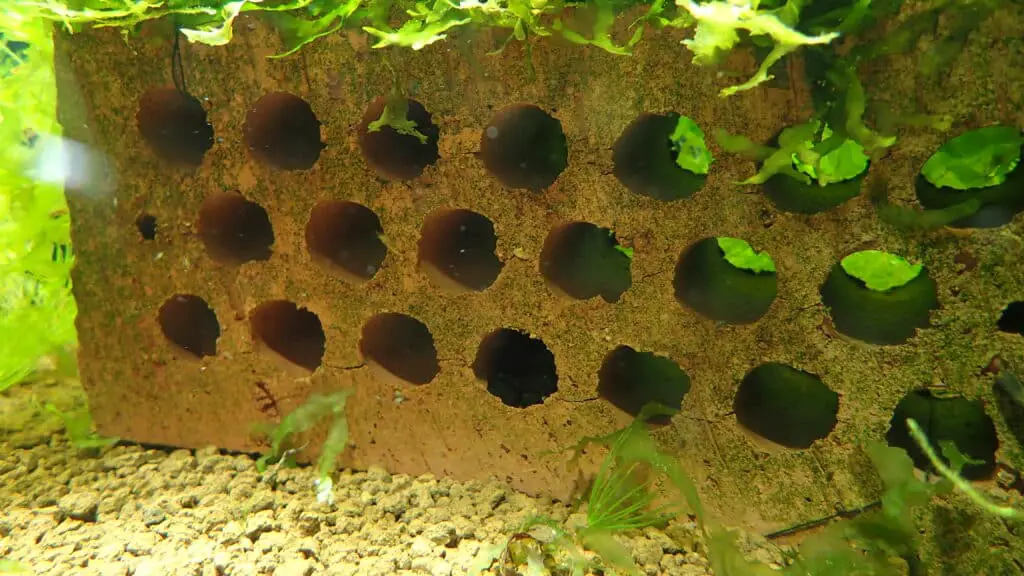
Offering Ample Hiding Spots: The Role of Shelter in Reducing Stress and Enhancing Cherry Shrimp Coloration
Providing an abundance of hiding places is another crucial factor in reducing stress and promoting better coloration in your cherry shrimp.
By creating a well-structured aquarium environment that mimics their natural habitat, you can ensure that your shrimp feel secure and comfortable, thus enabling them to achieve their full color potential.
- Aquatic Plants: Incorporating a variety of live plants into your aquarium can significantly contribute to a stress-free environment for your cherry shrimp. Dense plant growth not only offers numerous hiding spots but also aids in water filtration and oxygenation. Plants like Java moss, Anubias, and Cabomba are excellent choices for shrimp tanks, as they provide ample coverage and are relatively easy to maintain.
- Driftwood: Adding pieces of driftwood to your aquarium can create natural caves and crevices for your cherry shrimp to explore and hide in. Driftwood also contributes to a more authentic habitat and helps maintain stable water parameters by gradually releasing beneficial tannins into the water.
- Rocks and Stones: Incorporating rocks and stones into your aquarium layout can create additional hiding spots and contribute to a more natural, visually appealing environment. Choose smooth, non-toxic rocks and stones that won’t leach harmful substances into the water or injure your shrimp.
- Ceramic Shelters: Ceramic shelters, such as caves or tubes, can provide your cherry shrimp with safe and secure hiding spots. These can be purchased from aquarium stores or made at home using aquarium-safe materials. Be sure to select shelters with openings large enough for your shrimp to comfortably enter and exit.
- Leaf Litter: Adding leaf litter to your aquarium can create additional hiding places for your cherry shrimp while also mimicking their natural environment. Indian almond leaves, for instance, are widely used in shrimp tanks for their antibacterial properties and their ability to release tannins that help maintain stable water parameters.
Incorporating a diverse array of hiding places, such as plants, driftwood, rocks, ceramic shelters, and leaf litter, you can significantly reduce stress levels and promote better coloration in your cherry shrimp.
Remember, a stress-free environment is essential for your shrimp to achieve their most vibrant and intense colors.

Conclusion
Enhancing your cherry shrimp’s color naturally is achievable through various methods, including providing a diverse and balanced diet, using a dark substrate and background, allowing your shrimp to mature, maintaining excellent water quality, and keeping them in a social environment.
By implementing these strategies, you can help your cherry shrimp achieve their full color potential and create a stunning display in your aquarium.

FAQ: Frequently Asked Questions about Cherry Shrimp Coloration
- Q: How long does it take for cherry shrimp to develop their full color?
A: Cherry shrimp typically reach their full color potential when they are around one month old. However, their color may continue to develop and intensify as they mature, depending on factors like diet, water quality, and stress levels.
- Q: Is the coloration of cherry shrimp an indicator of their health?
A: While the coloration of cherry shrimp can be influenced by factors such as age, diet, and genetics, it can also be an indicator of their overall health. Stressed or unhealthy shrimp may display dull or faded colors. Ensuring optimal water conditions and providing a balanced diet can help improve their coloration and overall well-being.
- Q: Do cherry shrimp change color based on their surroundings?
A: Cherry shrimp can sometimes adapt their coloration to match their surroundings, primarily as a response to stress or to blend in with their environment. Providing a darker substrate and background can encourage your shrimp to display more vibrant and intense colors.
- Q: Why are some of my cherry shrimp less colorful than others?
A: The coloration of cherry shrimp can vary due to factors such as genetics, age, diet, and water quality. If you notice some of your shrimp are less colorful, it may be because they are younger or have not yet reached their full color potential. Additionally, the quality of the shrimp’s genetic line plays a significant role in their color intensity.
- Q: Can I breed cherry shrimp for more intense colors?
A: Yes, selective breeding can help produce cherry shrimp with more intense colors. By carefully choosing and breeding shrimp with the most vibrant coloration, you can improve the color quality of future generations. Keep in mind that this process can take time and multiple generations to achieve the desired results.
- Q: How can I maintain my cherry shrimp’s vibrant colors?
A: To maintain and improve your cherry shrimp’s coloration, ensure optimal water conditions, provide a balanced diet rich in nutrients and pigments, and create a stress-free environment with plenty of hiding spots. Regularly monitoring your shrimp’s health and adjusting their care accordingly can help them achieve their best possible coloration.
